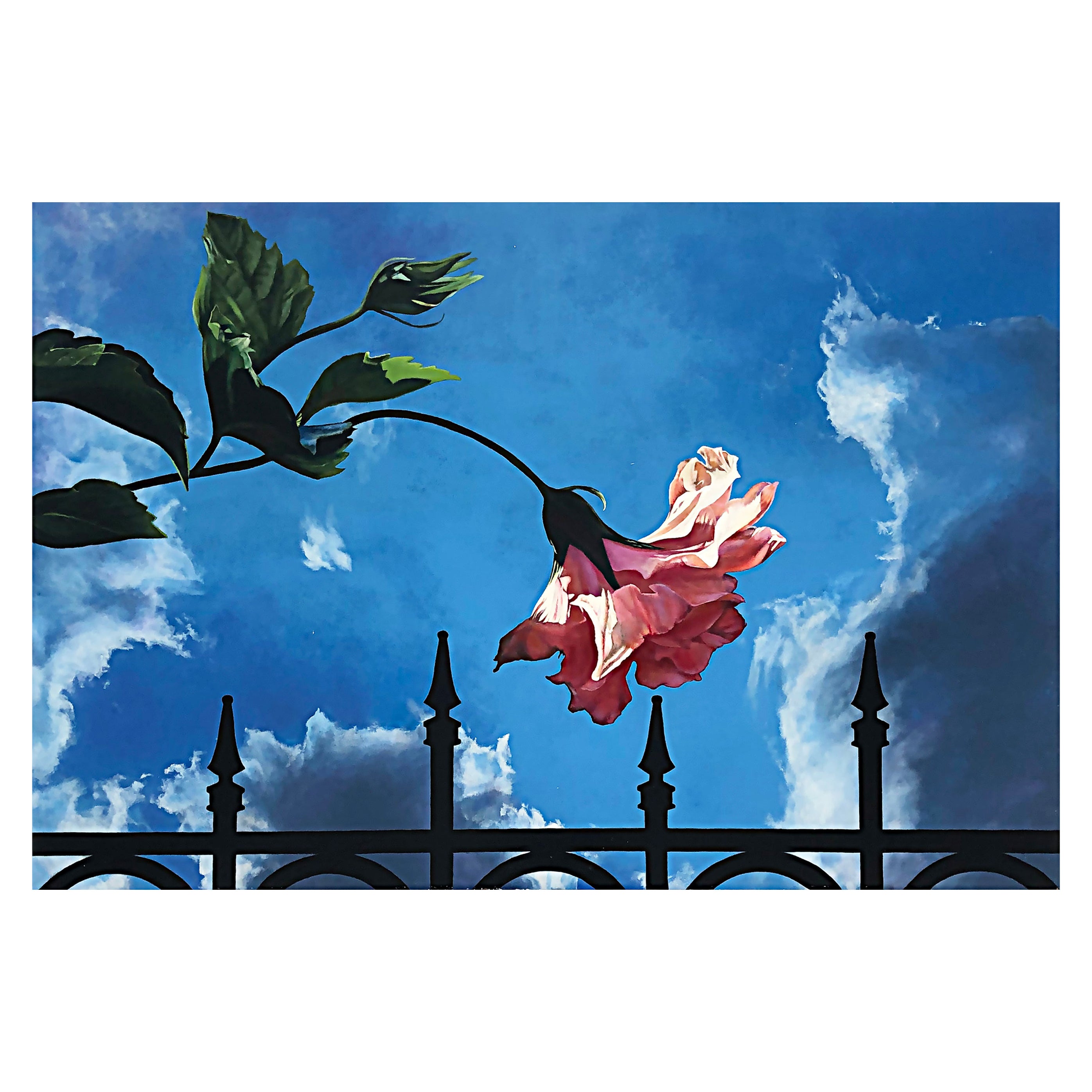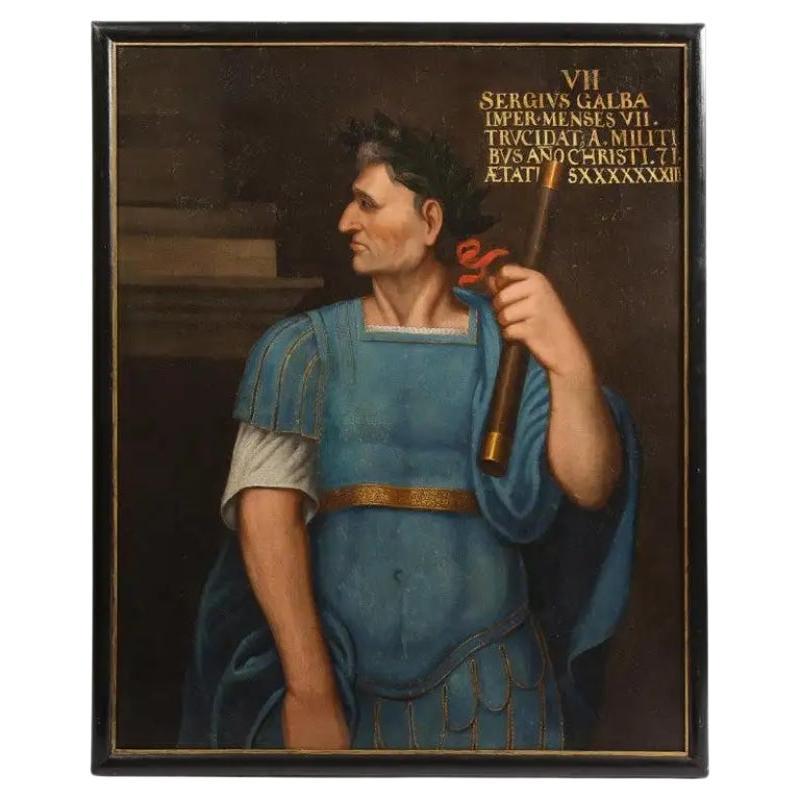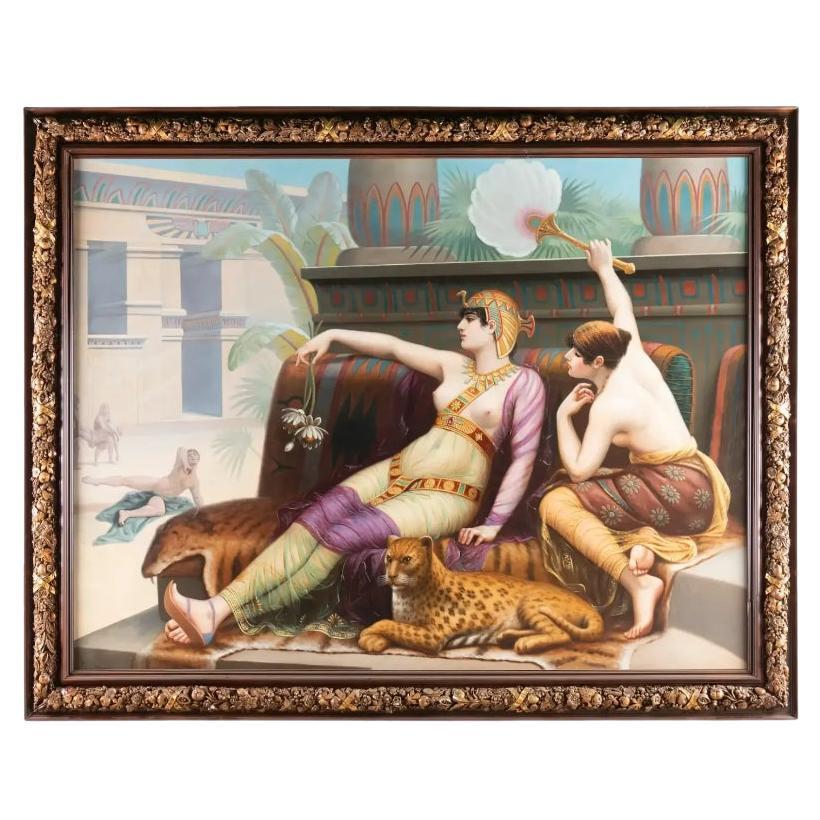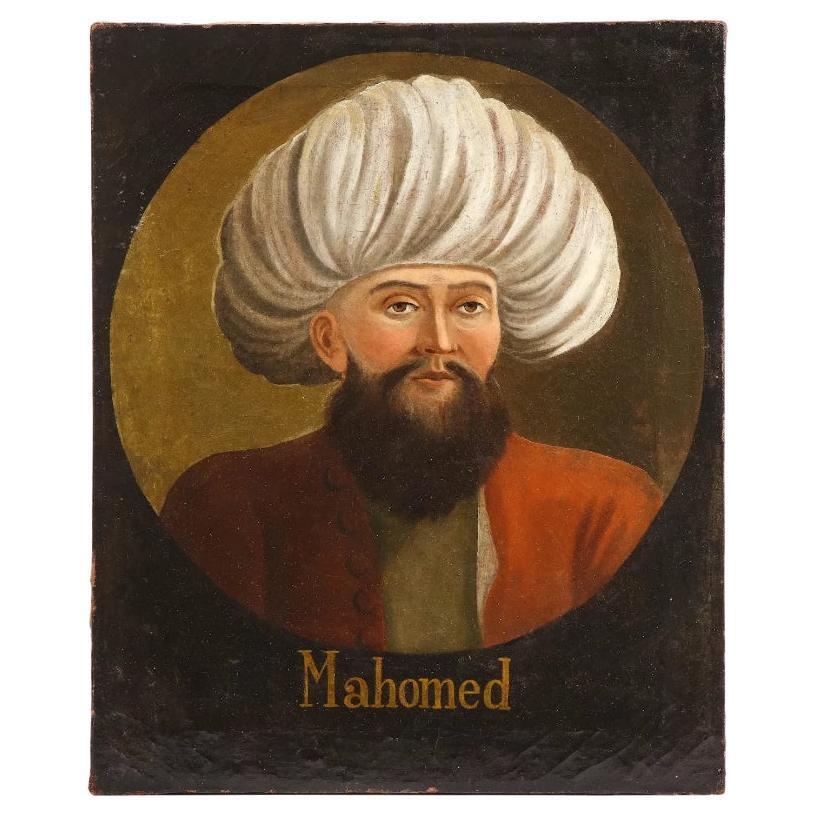Items Similar to Reply of the Zaporozhian Cossacks to Sultan Mehmed IV Painting after Ilya Repin
Want more images or videos?
Request additional images or videos from the seller
1 of 6
Reply of the Zaporozhian Cossacks to Sultan Mehmed IV Painting after Ilya Repin
About the Item
Reply of the Zaporozhian Cossacks to Sultan Mehmed IV of the Ottoman Empire, also known as Cossacks of Saporog Are Drafting a Manifesto.
Late 19th Century.
Monumental oil on canvas, set within an original carved giltwood frame. Unsigned.
Measures: Canvas: 62 X 105in (157 X 266cm).
Frame: 80 X 123in (204 X 312cm).
This painting is after Russian artist Ilya Repin. The Original 2.03 m (6.66 ft) by 3.58 m (11.74 ft) canvas was started in 1880 and finished in 1891. Repin recorded the years of work along the lower edge of the canvas. Alexander III bought the painting for 35,000 rubles, at the time the greatest sum ever paid for a Russian painting. Since then, the canvas has been exhibited in the State Russian Museum in Saint Petersburg. Vladimir Gilyarovsky, a popular journalist, was one of the models who posed for Repin.
Reply of the Zaporozhian Cossacks depicts a supposedly historical tableau, set in 1676 and based on the legend of Cossacks sending a reply to an ultimatum of the Sultan of the Ottoman Empire, Mehmed IV.
The painting exhibits the Cossacks' pleasure at striving to come up with ever more base vulgarities. During Repin's time, the Cossacks enjoyed great popular sympathy.
While working on the original version, Repin in 1889 began work on a second version. This work he never finished. The second version of "The Cossacks" the artist tried to make more "historically authentic". In 1932 it was presented by the Tretyakov Gallery to the Kharkiv Historical Museum. In 1935, it was moved to the Kharkiv Art Museum, where it is now stored.
- Attributed to:Ilya Repin (Artist)
- Dimensions:Height: 80 in (203.2 cm)Width: 123 in (312.42 cm)Depth: 5 in (12.7 cm)
- Materials and Techniques:
- Place of Origin:
- Period:
- Date of Manufacture:1880-1890
- Condition:Wear consistent with age and use.
- Seller Location:New York, NY
- Reference Number:1stDibs: LU179824235883
About the Seller
5.0
Vetted Seller
These experienced sellers undergo a comprehensive evaluation by our team of in-house experts.
Established in 1980
1stDibs seller since 2016
58 sales on 1stDibs
Typical response time: <1 hour
- ShippingRetrieving quote...Ships From: New York, NY
- Return PolicyThis item cannot be returned.
Auctions on 1stDibs
Our timed auctions are an opportunity to bid on extraordinary design. We do not charge a Buyer's Premium and shipping is facilitated by 1stDibs and/or the seller. Plus, all auction purchases are covered by our comprehensive Buyer Protection. Learn More
More From This SellerView All
- Emanuel Oberhauser, Full Length Portrait of an "Orientalist Queen" Oil on CanvasLocated in New York, NYEmanuel Oberhauser (Austrian, 1854-1919) an exceptional quality full length oil on canvas painting of a Young Orientalist Queen or Odalisque, 19th c...Category
Antique 19th Century Austrian Paintings
MaterialsPaint
- Monumental French Patinated Bronze Bust of William Shakespeare, After HoudonBy F. Barbedienne FoundryLocated in New York, NYA monumental French patinated bronze bust of William Shakespeare, after Houdon, by F. Barbedienne Foundry, circa 1870. Masterfully and realistically sculpted in solid bronze, this...Category
Antique 19th Century French Napoleon III Busts
MaterialsBronze
- Large Pair of Japanese Cloisonne Enamel Vases Attributed to Honda YasaburoLocated in New York, NYA large pair of Japanese Cloisonne Enamel vases attributed to Honda Yasaburo, 19th century. Finley decorated with the rich enamel colors of orange and green, these vases are desig...Category
Antique 19th Century Japanese Meiji Metalwork
MaterialsCopper, Enamel
- Large Pair of Japanese Cloisonne Enamel Lanterns Attributed to Kaji TsunekichiLocated in New York, NYA Large Pair of Japanese Cloisonne Enamel Lanterns Attributed to Kaji Tsunekichi, Edo Period, 19th century Japanese cloisonne lanterns were made during the Meiji period, from the late 19th to early 20th century, and were often used as decorative lighting fixtures in temples and shrines. Kaji Tsunekichi (1866-1916) was a Japanese cloisonné artist who was active in the late 19th and early 20th centuries. He was born in Tokyo and learned the art of cloisonné from his father, Kaji Sataro, who was also a cloisonné artist. He was renowned for his mastery of the shippo-yaki technique, which involves creating intricate designs with thin wires on a metal base before filling in the spaces with enamel. Tsunekichi was known for his exceptional technical skills and his ability to create intricate designs with vibrant colors. His works often featured nature motifs, such as flowers, birds, and fish, which were rendered in a highly detailed and naturalistic style. He also experimented with new techniques, such as plique-à-jour, a type of cloisonné that creates a stained-glass effect. Tsunekichi's works were highly prized during his lifetime and continue to be sought after by collectors today. He won numerous awards for his cloisonné creations, including a Gold Medal at the 1900 Exposition Universelle in Paris. His works are characterized by their fine wirework, precise enamel application, and attention to detail. Some of Tsunekichi's most famous works include a pair of large cloisonné vases...Category
Antique 19th Century Japanese Edo Metalwork
MaterialsCopper, Enamel
- Large Pair of Meiji Period Japanese Cloisonne Enamel Vases Attributed to GotoLocated in New York, NYA large pair of Meiji Period Japanese cloisonne enamel vases attributed to Goto Seizaburo, 19th century. These vases were made during the Meiji period (1868-1912) in Japan and are...Category
Antique 19th Century Japanese Meiji Metalwork
MaterialsCopper, Enamel
- Impressive Empire Style Malachite and Ormolu Center Table After DesmalterBy François-Honoré-Georges Jacob-DesmalterLocated in New York, NYAn impressive empire style malachite and ormolu center table after the imperial model by Francois Honore Georges Jacob-Desmalter, 1770-1841. "AUX CARIATIDES", Empire style round malachite and ormolu table inset within a profiled bronze border sitting on four distinctive caryatid supports on a round base with a central vase. Magnificent quality. A one of a kind, statement table perfect for any home. Measures: 34" high x 44" wide Good condition, ready to place. One of the most important and influential families of cabinet-makers who led fashion and standards from 1765 to 1847. Their work encompasses three generations of the family, from George Jacob (the founder, 1739-1814), to his two sons Georges II (1768-1803) and François-Honoré-Georges (1770-1841), and finally his grandson Georges-Alphonse (1799-1870). They ran one of the most successful and influential furniture workshops in Paris George Jacob (Senior) was one of the most prominent Parisian master menuisiers, producing carved, painted and gilded beds and seat furniture and upholstery work for the French royal châteaux, in the early Neoclassical style that is usually associated with Louis XVI. He retired in 1796, leaving his workshop in the hands of his sons, but when George II died, Jacob returned from retirement to oversee the constant supply of furnishings for Napoleon's residences. François-Honoré-Georges Jacob-Desmalter was the principal supplier of furniture to the Emperor and also received commissions from Pauline Borghese...Category
Early 20th Century French Empire Center Tables
MaterialsMalachite, Ormolu
You May Also Like
- Shtetl, Oil Painting by Ilya SchorLocated in New York, NYOil on board, New York, circa 1950. Depicting a standing bearded man wearing his tzitzis over his shirt pumping water to his horses. Signed lower right “I. Schor”. Ilya Schor (1904-...Category
Mid-20th Century American Paintings
MaterialsPaint
- Five Cossacks Oil Painting on BoardLocated in Lambertville, NJOil on board painting off five (5) Cossacks. signed possibly Martin Galambos dated 1914. Original wood frame with some chips and loss from age. Measures: 32"wide by 19" tall. Excell...Category
Vintage 1910s Unknown Paintings
MaterialsPaint
- Original Orientalist Painting Depicting the Sultan’s Concubine in the HaremBy Antonio RivasLocated in New York, NYOriginal 19th century orientalist painting depicting the Sultan’s concubine in the Harem by Antonio Rivas. Signed A. Rivas (CR) A...Category
Antique Late 19th Century Spanish Paintings
MaterialsCanvas
- Babe Ruth, the Sultan of Swat, Original Painting by Lynn CurleeBy Lynn CurleeLocated in New York, NYBabe Ruth — The Sultan of Swat Original painting by Lynn Curlee Acrylic on stretched canvas. Gallery wrapped with painted edges. This painting was used as...Category
Early 2000s American Modern Paintings
MaterialsAcrylic
- The painting "The road to the forest".Located in Chorzów, PLThe picture is painted with oil paint on canvas. Origin : Scandinavia Dimensions: Frame: height 58 cm / width 45 cm Image: height 54 cm / width 41 cmCategory
Vintage 1950s Scandinavian Other Paintings
MaterialsCanvas
- Victorian Crystoleum Picture after A L Vernon The Messenger to the Heiress, 1896By (After) Arthur Longley VernonLocated in Lincoln, LincolnshireThis is a very decorative Victorian period Crystoleum picture after A L Vernon called The Messenger to The Heiress and dating to the late Victorian period,...Category
Antique Late 19th Century English Late Victorian Decorative Art
MaterialsGlass, Wood
Recently Viewed
View AllMore Ways To Browse
Alexander Iii
Drafting Set
Ilya Repin
Paintings Cossacks
Antique Drafting Sets
Scarpa 1934 Chairs
Wegner Poster
Bfk Chair
Antique Pair Display Cabinet
Antique Iron Door Hinges
Elios Chair
Italian Inlay Chest Of Drawers
Plata Lappas
Victorian Lock Cabinet
Swedish Gustavian Painted Chest
Period Desk Chairs
Vintage And Antique Chests
Aalto 900





